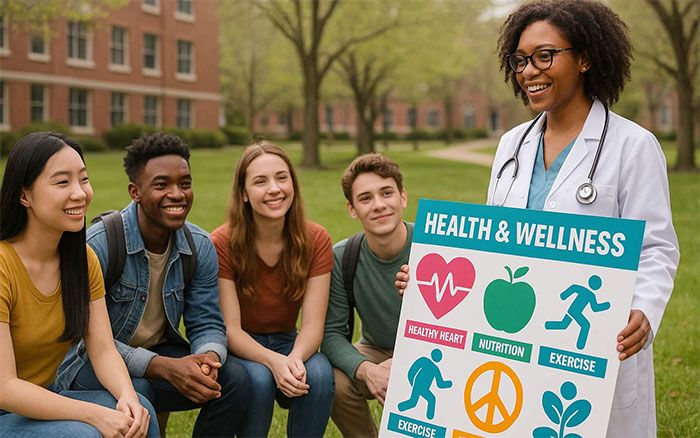Improving Health Communication in Higher Education
(Best Practices and What to Avoid)
We all know what happens when communication breaks down – chaos erupts! Effective health communication is vital for promoting wellness and managing health concerns on college campuses. Understanding and applying best practices in health communication can significantly enhance health services utilization and the overall well-being of the student population.
Let’s dive into the essential elements of effective health communication, the application of health literacy models and plain language guidelines and identify common errors and opportunities for improvement.
Best Practices in Health Communication
1. Know Your Audience
Understanding the diverse backgrounds, experiences, and needs of your student population is crucial. Tailor your messages to address the specific concerns and preferences of different student groups, such as international students, students with disabilities, or those from various cultural backgrounds.
2. Utilize Multiple Channels
Students access information through various channels, including social media, email, campus websites, and physical materials (flyers, bulletin boards, etc.). Ensure your health messages are distributed through multiple platforms to maximize engagement. Use engaging visuals and multimedia content to capture attention and make information more accessible.
Learn more about promoting campus resources through social media here.
3. Be Clear & Concise
Clarity and brevity are essential in health communication. Avoid medical jargon and complex language that may confuse or overwhelm students. Use plain language guidelines to ensure your messages are easily understood. For example, instead of saying “administer medication,” use “take medicine.”
4. Foster Foster Two-Way Communication
Encourage feedback and dialogue with students. Create opportunities for students to ask questions, share concerns, and provide input on health initiatives. This can be done through online forums, in-person events, anonymous surveys, or suggestion boxes. Two-way communication builds trust and ensures that your messages are relevant and effective.
Applying Health Literacy Models and Plain Language Guidelines
Health Literacy Models
Health literacy involves the ability to obtain, process, and understand basic health information to make informed health decisions. Applying health literacy models can enhance the effectiveness of your communication efforts.
The Health Belief Model (HBM): The HBM can help predict and explain health behaviors by focusing on individuals’ beliefs about health conditions, perceived benefits of action, and barriers to action. Use this model to design messages that address perceived risks and emphasize the benefits of adopting healthy behaviors.
For example, to encourage students to get flu vaccinations, you might highlight the perceived severity of the flu by sharing stories of severe cases and the high risk of contagion in a campus environment.
Simultaneously, emphasize the benefits of vaccination, such as increased immunity, reduced absenteeism, and protection for vulnerable peers and campus staff. Address barriers by providing information on convenient campus vaccination clinics, reducing cost concerns, and dispelling myths about vaccine safety.
The Socio-Ecological Model (SEM): The SEM considers the complex interplay between individual, interpersonal, organizational, community, and societal factors. Use this model to develop multi-level interventions that address various determinants of health and create supportive environments for behavior change.
For example, to encourage college students to take care of their mental health, you could implement individual-level strategies like providing access to online self-help resources and counseling services. At the interpersonal level, facilitate peer support groups and mental health awareness training for student leaders.
Moreover, advocate for policies that reduce academic stress, such as flexible deadlines and mental health days. Community-level interventions might include partnerships with local mental health organizations to provide workshops and resources. Lastly, at the societal level, engage in advocacy efforts to reduce stigma around mental health and promote broader cultural acceptance of seeking help.
Plain Language Guidelines
Plain language guidelines emphasize clear and straightforward communication. Here are some key principles:
- Use simple words and sentences: Replace complex terms with simpler alternatives. For example, use “high blood pressure” instead of “hypertension.”
- Be direct: State your main message at the beginning and keep sentences short.
- Use active voice: Active voice is more engaging and easier to understand. For example, “Wash your hands” is better than “Hands should be washed.”
- Organize information logically: Use headings, bullet points, and numbered lists to break down information and make it easier to scan.
Common Errors and Opportunities for Improvement
Error 1: Overloading Information
Providing too much information at once can overwhelm students and reduce the likelihood of them retaining key messages. Focus on delivering essential information in manageable chunks.
Opportunity: Prioritize and segment information visually. Use infographics and summaries to highlight key points.
Error 2: Ignoring Cultural Sensitivity
Health messages that do not consider cultural differences may be ineffective or even offensive to some students.
Opportunity: Engage with diverse student groups to understand their perspectives and tailor messages accordingly. Use culturally relevant examples, images, and language.
Error 3: Lack of Visual Appeal
Plain text messages may be ignored or overlooked, especially in today’s visually-driven digital landscape.
Opportunity: Incorporate visuals, such as images, videos, and infographics, to make messages more engaging and easier to understand.
Error 4: Inadequate Follow-Up
Sending out a health message without follow-up can lead to low engagement and missed opportunities for behavior change.
Opportunity: Use automated reminders and follow-up communications to reinforce messages. Provide support to encourage sustained behavior change.
Key Takeaways
Effective health communication on college campuses requires a strategic approach that considers the diverse needs of the student population. By applying health literacy models, adhering to plain language guidelines, and addressing common pitfalls, colleges of all sizes can enhance their communication efforts and promote a healthier campus environment.





















